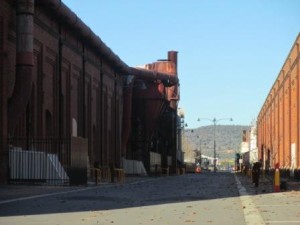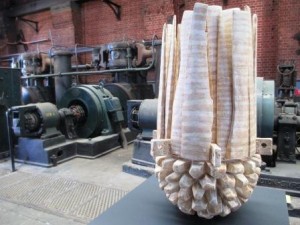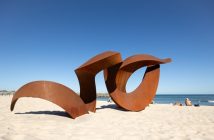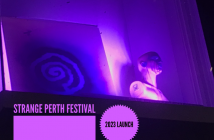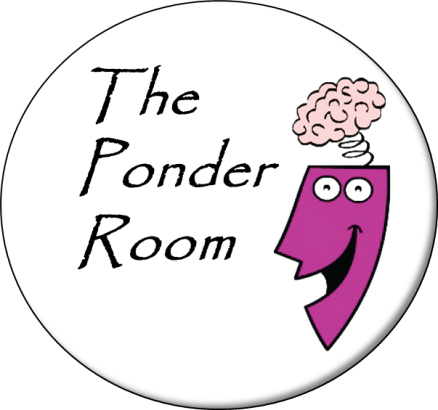Last weekend I went to Form’s latest exhibition at the Midland Atelier site. The visit was organised by the Friends of the Art Gallery of WA. Entitled Paper Cotton Leather Flowers Wood, the exhibition is a reflection of Form’s 5th anniversary (i.e. the wedding gifts you get each year). I’d never been to the old Midland Railway Workshops site before so it was a case of two treats in one. The buildings, the largest Edwardian Industrial site in the southern hemisphere, would have been enough in themselves, add in the beautiful pieces and some ghostly stories and I was hooked. I highly recommend you make the effort to see this exhibition, in the meantime I’ll be writing a couple of posts to help give you a sense of just some of what was on offer.
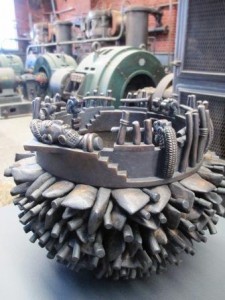 |
| Tanija Graham Carr Midland Workshop
© 2013 The Ponder Room
|
Specifically made for this exhibition the pieces echoed their surroundings looking like they too were cast metal, stone and even bones.
The idea of the bones was magnified further when some of the staff on hand relayed stories of ghostly apparitions seen on site. Hearing this made me extremely pleased that I was seeing the exhibition during the daylight.
I’ve never seen anything like their work, and the Form representative agreed saying that, to the best of their knowledge, this duo are the only people using these techniques. Hardly surprising then that they keep their methods to themselves.
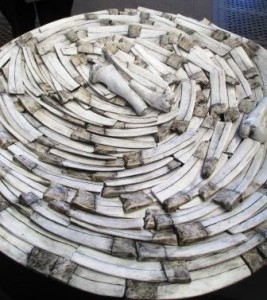 |
| Tanija Graham Carr Midland Workshop
© 2013 The Ponder Room
|
Next stop was Eva Fernandez’s Flowers. The perfectly placed slideshow creating an immensely spooky atmosphere, that only added to the ghostly tales.
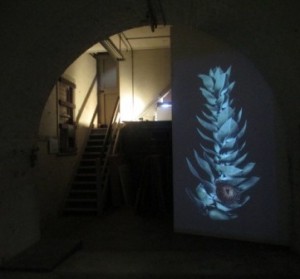 |
| Eva Fernandez Midland Workshop
© 2013 The Ponder Room
|
Evidently the Pattern Makers were the highest paid and most respected members of the workforce. Fernandez was inspired after seeing pallet on pallet of the models. They’d been randomly positioned which had created interesting patterns. Her images were a wonderful reminder of the origins of the site.
Nowadays this part of the site hosts up to fifteen designers and artists-in-residence, some of whom were working that day.
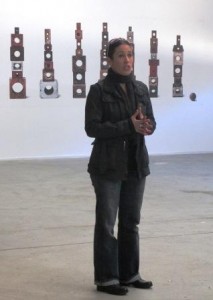 |
| Eva Fernandez Midland Workshop
© 2013 The Ponder Room
|
For ‘Cotton’ respected artist Nalda Searles was on hand to explain her piece, along with more history. It was unbelievable to hear that for all the thousands of people, mostly men, who’d worked in the Workshops, even though there were countless injuries and a lack of protective clothing, there were only 22 deaths in over 90 years. Now that’s a stat to warm the heart of any OCHS officer.
Searles, herself a retired nurse, told us about ‘Iodine Annie’ who worked in the nurses station, often treating men for blindness. The station housed some of the medical equipment used in the day including a bed which Searle had adorned with a writhing snake. On closer look the belly of the snake was made up of woven x-rays, Searles own x-rays.
 |
| Nalda Searles Midland Workshop
© 2013 The Ponder Room
|
She explained the significance of the snake, harking back to the large number of snakes found on the site. Something I possibly didn’t need to hear. Her other piece was a woven skull under glass. I wasn’t too sure what the ghosts would have thought of that.
Lastly came Paper with Susan Flavell’s interpretation of Cerberus (the three-headed dog who guards the underworld). This time he stood guarding the Foundry doorway. After marveling over the size of the piece, it was interesting to hear that the Foundry made small items like the train drivers watches, as well as massive engine parts.
Equally ‘interesting’ was …
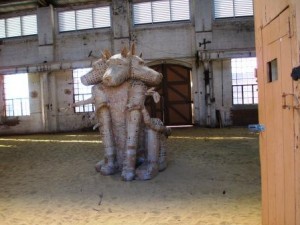 |
| Susan Flavell Midland Workshop
© 2013 The Ponder Room
|
… the tale about a cupola of molten metal that had been upended one day, injuring six workmen and killing one, their ghosts haunting the Foundry site today.
As I drove out of the Workshop, several hours later, I pondered …
- How nice it was that, even though some parts of the site were ‘dangerous’, we were allowed to wander through the exhibition pretty much at your own rate.
- It’s good that some techniques are kept secret, it makes it all the more interesting to ponder how on earth the Carr’s did it.
- The brilliance of our WA artists
- A big thank you to Susan Flavell’s Cerberus who protected me from workers past, as I lingered in the Foundry … alone.

